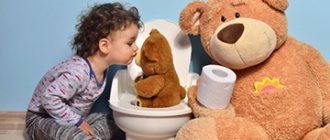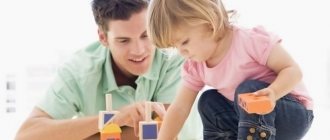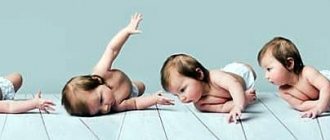As soon as children reach the age of 2-3 years, it’s time to work with them on counting more seriously than just telling them what “little” and “many” are, and how much “2 + 2” is. This age period is characterized by maximum cognitive activity, and cognitive abilities reach their peak. That’s why the children themselves are distinguished by their curiosity and desire to learn something they couldn’t do before. As a result, the incoming information falls on fertile soil, and then begins to be actively used by children in their interaction with surrounding objects and people.
But when teaching a child to count, you should always keep in mind that some data may be somewhat problematic to assimilate. A child may, for example, miss some numbers from a number series or completely change their order. The reason for this is the selectivity of children's memory - for the most part, what aroused an emotional response in the mind, in particular interest, is retained in it. Therefore, training should be based on several fundamental principles that you definitely need to become familiar with.
1
The benefits of mental counting
After conducting research, scientists concluded that the modern generation is experiencing a decrease in the activity of mental abilities. This is due to the emergence of gadgets and devices aimed at simplifying our lives.
For example, modern children are increasingly using a calculator when performing tasks related to mathematical calculations, neglecting mental calculations. This is a deplorable trend, because... mental calculations contribute to the activation of students’ mental activity. This is one of the best brain trainers because... it promotes:
- memory development;
- concentration;
- ability to perceive what is said by ear;
- speed of reactions;
- speech development.
It is not difficult to activate the work of brain cells; to do this, you just need to count as much as possible orally, because solving even simple examples of subtraction, addition, division and multiplication has a beneficial effect on the development of thinking.
But before you begin the above mathematical calculations, you first need to teach your child to memorize numbers.
What determines mathematical abilities?
- From concentration.
- From a predisposition to mathematics.
- From knowledge of special algorithms.
- From training and experience.
Training and experience are key. Experience, as we know, comes with age, and if you have a small child, it would be a good idea to start teaching him to count from a very early age. Of course, you don’t have to make your child a child prodigy, but the ability to count well in your head can make his life much easier in the future.
Best age to start learning
Parents often ask the question: “Is it necessary to teach a child oral language before entering first grade?” The answer is clear: “It is necessary.” Training should begin after the child begins to show interest in the subject.
Experts say that the most favorable age for learning to count is from 3 to 5 years. Upon reaching three years of age, most children already have a rudimentary understanding of objects; they are already able to start learning numbers.
At four years of age, children are able to perform simple math operations such as subtraction and addition, and by age five, children can begin to learn to solve simple problems on their own.
Let's move on to oral addition and subtraction within 10, 20
A non-standard format that captivates a child from the first minutes - entertaining mathematical puzzles, puzzles and logical problems on the LogicLike.com platform. The child simultaneously trains mathematical abilities and develops logic.
Where to begin?
- Check out our math problems for 1st grade,
- as well as logical tasks for children 7-8 years old;
- solve 5-10 puzzles together;
- save the result on the platform.
After 2-5 joint lessons, feel free to leave your child to study independently. It is enough for a parent to monitor progress once a week.
Preparing for training
Before moving on to teaching, adults must first of all explain to the child what a number is and what a figure is. Young children do not see the difference in these two units. In order to demonstrate the use of mental counting, it is worth using educational material already familiar to the child, for example: soft toys, dolls, cars, cubes, balls.
Training should be carried out in the form of an entertaining and dynamic game in order to arouse the student’s interest. If the child is tired, it is better to end the lesson. When children perceive learning as an exciting game, it subsequently becomes one of their favorite activities.
Listen, watch, sing, read: children 4-5 years old
Illustrated books with funny stories or poems about numbers will be no less exciting for a child. They can be retold or learned by heart.
Educational videos and cartoons will teach your child how to count simply and clearly. Series about mental arithmetic can be found in almost all popular animated series. You can find counting songs that children remember as two and two.
But remember that you should not completely transfer a child at this age to self-education. It will not replace full-fledged classes with parents.
Is everything we described above a passed stage? It's time to start solving the main task: quickly and easily teach your child to count in his head.
How to teach a child to count
Learning mental arithmetic should take place daily in the form of an exciting game. Classes should be carried out continuously, devoting 20-30 minutes every day to studying numbers and addition and subtraction skills; when the child gets used to it, he will be able to play educational games without the help of adults.
Each new lesson must have its own algorithm and system. To begin with, you should consolidate the material you have learned, and then move on to learning new things. An important point is to explain the terms: more, less, one, many.
When explaining the material, you need to use all available means, for example, when preparing lunch, you can ask the child to count how many potatoes have been peeled; When going down the stairs, you can count the steps.
A good exercise would be a visual illustration of how objects shrink or grow, for example, you can put two dolls next to each other, and then remove one and ask the child what happened.
Learning to count to 10
Most children begin to become interested in numbers around the age of three, some later. If parents notice that the child is showing interest in counting subjects, it’s time to start teaching.
In order to explain to a child how to count to ten, you first need to help him remember the name of the numbers, clearly saying what goes after what. You can use available teaching material for this: cubes, toys.
After the memorization process is completed, you need to ask the child to count everything that catches his eye: dishes in the kitchen, scattered toys, people meeting on a walk, birds sitting on a branch.
First you need to master counting within 8, and then move on to numbers 9 and 10.
You can’t ignore the number 0. It’s initially difficult for children to understand its meaning; to explain, you can use the same material at hand: put two dolls next to each other, first remove one, and then the second, ask how many dolls are left.
Gradually, you need to introduce the concept of quantity into a child’s life; special poems about numbers will help with this. The counting machine also helps teach counting.
Educational video material will also come to the aid of parents. The characters show special exercises for counting to 10 for children of the younger age group, by performing which the child can easily master and consolidate new knowledge.
Learning to count to 20
After children have mastered counting to 10 and can draw a parallel between the drawn number and the number of objects, it is time to move on to learning new numbers. The task will become more difficult, because Now you need to explain to the little student what units, tens and a complex number are.
To make the process of learning new numbers easier, you need to adhere to the following recommendations:
- Separately, you need to familiarize children with each number. It is necessary to write the number on paper, talk about it and illustrate it, for example, if we were talking about the number 12, you can draw 12 cars.
- Pay special attention to the number 20. Tell that this is the highest digit in the second ten.
- Pronounce each number separately, having learned several new numbers, start repeating over again.
- When learning to count, we must not forget to tell children about the meaning of numbers and what they are needed for.
- Start writing down numbers. Ask the child to write down all the numbers in order and pronounce their names loudly when writing. This way the memorizing process will become more productive.
- Add items to activities. It will be much easier for children to understand new material if they are given blocks, sticks or pencils that they can touch. The lesson will become more interesting, because... children will count and use unusual objects.
Many parents are interested in: “How to teach a child to count units and tens?” The best way to explain the difference between tens and ones is in the form of a game. For example, take two cups and a pack of cookies.
Ask your child to put 10 cookies in one cup, while counting out loud. When he does this, explain that this is called a “ten”, and it consists of ten “units”, and one cookie is one unit. After this, ask to put a dozen cookies in the second cup, while also counting out loud. Ask how much the cups of cookies cost now, and how many dozens there are in total.
Learning to count to 100
When counting to 20 is mastered, the concepts of ones and tens do not cause difficulties; some children independently begin to show interest in naming other two-digit numbers.
In order to teach children to count to 100, you can use the same rules as when teaching them to count to 20. If the information is not easy to come by, you can use the following techniques:
- Don’t rush children to count in round tens; let them first master ordinal counting: 61,62,63, etc.
- Use the game "Department Store". Cut up toy money, lay out the goods, set a price on them, and invite the child to do the shopping. This game will also help instill frugality.
- Use the Lotto game. Thanks to it, children will learn to name complex numbers in a playful way.
- Use a tape to measure your height. In many apartments these tapes hang in children's rooms. You need to ask the child to measure his height and name it, or ask him to measure all the large soft toys, etc.
Counting to ten
When wondering how to teach counting to 10, you can think about using special exercises and games.
- Introduce the baby to his fingers, show that there are five of them on one hand, and also five on the second, but ten in total. Count each finger, bending them one by one.
- Show your child pictures of objects in different quantities, for example, three apples, five balls. But do not rush to show the number; for now, draw the child’s attention only to the number of objects.
- There are many programs for baby development, as well as educational cartoons. It will be doubly interesting for a child to understand counting if he is taught by characters from the TV screen.
My son watched this cartoon series. There, Mickey Mouse and other Disney characters taught logical thinking, numbers and counting. Nikita really liked it, he happily answered all the characters’ questions and was very happy that he was giving the correct answer.
- Use the abacus. That's how I was taught at the time. Today there is a wide variety of them on sale. This device will help develop your child’s fine motor skills and introduce the basics of counting.
- Rhymes using counting or numbers are effective. You can learn them by heart with your child.
- Always pay attention to everything around you.
When my son was three years old, I intensely began to draw his attention to the cars passing by, to the number of toys the children had, to the cats that were lying near the entrance, to the number of steps we climbed.
How to teach your child to add and subtract
When starting to teach mental arithmetic, you should first of all take into account the age characteristics of children.
If we are talking about a child of primary preschool age, it would be advisable to start studying the material with the simplest examples and problems, first explaining what a number is and what a figure is; Gradually explain addition and subtraction to your child.
For older preschoolers, more complex games and techniques are suitable - those in which you need to practice addition and subtraction skills, for example, the game “Shop”.
For children 2-3 years old
It will be easiest for children of this age group to learn to count using their fingers. For example, you need to sit next to the child, start bending his fingers one by one and count out loud.
After children can independently bend their fingers and count at the same time, they can move on to the next stage - an explanation of addition and subtraction. The best way to do this is through a game.
For example, say: “Mom has one piece of candy. Extend one finger. Dad has three candies. Extend three more fingers. How many candies did you get? Count your fingers. One two three four. Right!"
Or like this: “Mom has five sweets. Extend your five fingers. Dad took two candies from mom. Bend two fingers. How many candies does mom have left? Count the remaining fingers. One two Three."
For children 4-5 years old
Children aged 4-5 years are most comfortable explaining the principles of addition and subtraction using educational material, which can be their favorite toys.
For example, you can put five dolls next to each other, then add two more, ask the child how many you got, then add one more, ask how many dolls you got now. Or put seven cars in a row, roll back three, ask what happened and how many cars are left now.
You can conduct training using any surrounding objects: cubes, sticks, cards. You can also purchase copybooks “Learning ordinal counting up to 5,10,20 and 100.”
For children 5-6 years old
To teach counting to children from 5 to 6 years old, the same game techniques are suitable as for four and five year olds.
Tasks can be complicated by giving the child compound examples to solve, for example 2 + 2 – 1; a counting ruler for preschoolers will help solve such problems. The main thing that parents should focus on is how to explain to their child what a plus and a minus are. It is important from the very first days of classes to give a clear definition of these terms: plus is when something is added, and minus is when something is decreased.
For 1st grade students
Children entering first grade is an important stage in their lives. At this time, the child’s sphere of activity changes, he tries on the role of a student.
To achieve positive results, taking into account the age of schoolchildren, teachers practice learning mental arithmetic in a playful way:
- Zaitsev's method. Gaining new knowledge occurs through the use of special cubes and tables.
- Glen Daman method. Learning to count is carried out using cards on which a separate number of dots is located.
- Polyakov's method. Children learn about numbers and numbers by arranging colorful cubes and filling boxes with holes.
For 2nd grade students
By this time, younger schoolchildren should already have mastered the basic skills of mathematical operations.
The use of gaming techniques fades into the background, the emphasis is on solving examples in notebooks and at the board. Children are given simple problems to solve that involve complex numbers and tens.
In addition to school activities, parents are recommended to train their child's addition and subtraction skills at home. It is necessary to give the child examples, ask him to subtract another from one number. The more practice you have, the easier it will be to learn.
“The language of numbers” and mathematical problems out of thin air
We adults think in numbers every day, but we don't always say them out loud. But children may be interested in the “language of numbers”: “What time did we wake up today? At 7 o'clock in the morning. What bus were you waiting for at the stop? 12th. How many minutes did it take? 10".
Gradually, just naming numbers will become boring. Show your child how interesting it is to count everything that surrounds him: entrances to the house, cars in the parking lot, trees near the playground, house numbers. If you're a resourceful parent, you can come up with little addition and subtraction math problems on the fly.
It has been noticed that the child will count what he likes with greater enthusiasm. Therefore, the well-known problems with candy act like a magnet.
At home, the child always has something to count. You can follow the clock hands and turn measuring your weight and height into a game. A tear-off calendar or a toy calendar in which you need to turn over cubes with numbers every day keeps children occupied for a long time.
But this Lego calendar needs to be disassembled and reassembled every month.
For children of senior preschool age
All of the above exercises can be made more difficult. Try writing word problems together based on what you saw during the day. Let your child count more in his head when solving applied problems.
In general, it will take time to come up with interesting problems on your own or find quality material on the Internet.
Zaitsev's technique
This teaching method will help teach the student logical reasoning, analysis and generalization of the information received. Most often, this technique is used for students in grades 1 and 2.
- Children are given special cards with numbers from 0 to 99 and tables that show the composition of the number. The required number of cells is shaded.
- Children become familiar with the numbers in the top ten, determining their composition.
- The next stage: performing arithmetic operations with numbers.
- It is recommended to write down examples.
Recommendations for parents
In any business, patience and perseverance are important. You don’t need to think that the result will come from the first days. To achieve success, you need to follow a few simple rules:
- During classes, take a closer look at the child’s behavior and understand whether he is interested or bored. If the second option, then change the teaching method.
- Don't force yourself to study. It’s better to explain to your child why it is important to learn to count, and then he himself will want to learn.
- During lessons, do not yell at your son or daughter, do not break down, and especially do not raise your hand.
- Review the material you have covered every day.
- Praise your child for every achievement.
- Consolidate the information received in everyday life. For example, count the pigeons in the park or the number of cutlery during dinner.
- Give your child tasks that correspond to his level.
Remember that mental arithmetic develops culture and clarity of thought, speed of reaction, clarity of mind, and quick wit. It gives the child confidence in his abilities and helps him master the entire school curriculum. Not only mathematics and physics, but also subjects in the humanities and natural sciences.
Polyakov's technique
You can teach your child mathematics using Polyakov’s method. To do this you will need colored cubes and a box with cells in which they can fit. Thanks to this set, concepts are explained to students: tens, composition of numbers. This method also contributes to the development of mental calculation techniques.
To achieve positive results, teachers advise conducting lessons in a playful way. For example: ask children to imagine that the box is a garage and the blocks are cars. There were 3 cars in the garage, then 4 more cars arrived. How many cars are there in the garage?
Over time, tasks become more complex with the transition to tens and two-digit numbers.
Counting materials
The choice of counting materials today is very rich. The most famous are counting sticks. Parents are attracted by their ease of use and affordability. However, simplicity does not lead to high efficiency. The child becomes dependent on the template and cannot translate such counting into oral.
There are many cards: “Composition of numbers”, “Number houses”, “Flower”, “Dominoes”. All of them are sets of composite counting material with variable characteristics. The child learns to find components in a number, that is, he learns that ten consists not only of two 5s, but also of 8 and 2, 7 and 3, and so on.
Wooden and plastic sets of numbers and calculation signs with sticks included are also an excellent way to develop visual memory by correlating the number of sticks and the number. Classic abacus and abacus with sound are also great for learning the composition of numbers. The method of decomposing numbers by adding up to ten and the remainder to obtain the answer is clearly expressed here.
Digital reels with numbers and signs are used for more experienced children. The principle is simple: the child turns wheels with numbers and signs and gets a clear example for solving. For the little ones - pyramids and pins. Simple counting and shifting will help in remembering numbers.
It is more interesting for the baby to create counting materials together with his mother. Draw together, create boxes with numbers and fill them with beads, count markers, pencils, make a number and, accordingly, peas or bagels. That is, combine different methods and methods of calculation for better memorization.
Learn to count by playing
As mentioned above, the key to effective learning for children of preschool and primary school age is the game form. Games can be very different, from specially designed to spontaneous, the main thing is to make the child think.
You can play “Shop” with your children. Invent your own currency, set prices for goods (based on the student’s abilities) and “sell” them to the child. The game "Funny Ball" will help bring mental counting skills to automaticity. You need to throw a ball to the child and name an example that he must solve.
Simple games with numbers will help introduce your child to arithmetic operations
Cubes, magnets, cards, counting sticks - the most standard materials for teaching counting. But the child will quickly get bored with them. It will be much more interesting for him to play with what he makes with his own hands. You can get creative with your child and make your own games to learn numbers and practice simple mathematical operations.
There are interesting uses for shells brought from the sea. This game will help younger preschoolers quickly learn to add and subtract. Now abstract arithmetic operations can be seen with a clear example.
Don’t rush to throw away the egg tray and kinder capsules either, they can be turned into a fun game. The photo shows an option with addition, but it can be replaced with subtraction, multiplication or division. The good thing about the game is that the child can “disassemble” and “assemble” new examples with his hands.
Constructors like Lego are also suitable for learning counting. Games like these help develop fine motor skills, logic and spatial thinking.
Has your child mastered the games “live” and felt the counting “on his fingers”? Now he is definitely ready for mental counting.
Number houses
Houses with numbers are the next step in learning the composition of numbers. They are a building with a roof and two apartments on each floor. There is always a number on the roof that splits into two others that live next door to each other. The number of floors depends on the number of possible combinations: the higher the number, the more options for laying it out and the higher the house.
To understand the composition of a number with your child, just draw such a house. For example, for the number 3 it will have 2 floors, on which 0 with 3 and 1 with 2 are adjacent
Having explained the main principle, you need to give children the opportunity to fill out the number houses on their own: leave them empty and indicate only the number on the roof, the composition of which must be distributed among the floors. You can start from the bottom floor or from the top.
If the task is difficult, you can fill in some of the boxes as a hint. But in the future it should be explained that each number, moving from one floor to another, becomes 1 more or less. And if in one apartment there is a decrease of 1, then in the next one there will be an increase of 1.
After the compositions of numbers up to 10 have been mastered, you can move on to the second ten, if the child is familiar with it.
Basic Rules
To prepare for future educational activities, it is important to teach how to count from left to right. The counting row is lined up; when counting, items are taken or indicated one at a time. Right-handers lay out the row with their right hand; for left-handers, the left hand is acceptable.
Other rules:
- Place items in a row at regular intervals.
- When naming a number, relate it to each element you count.
- Match nouns in gender, number and case (one apple, three cubes, etc.).
- You can count quantitative (one, two, three), and then ordinal (first, second, third) numerals. For cardinal numbers, ask the question: “How many in total?” For ordinal ones - “What is the count?”
- Keep counting slowly, without skipping objects, without pointing to the same thing twice.
- Teach your child to answer the question “how much?” answer “once”, not “once”.
- After mastering the counting of visible elements, start counting using other analyzers: sounds, objects by touch or movements: how many times will I jump, hit the table, clap my hands, etc.
- The drawn numbers will help you correlate the quantity and number. It’s good when the corresponding number of objects is shown next to the number. You can quickly make such cards yourself or buy special children’s books with numbers in the store.
- Combine learning to draw and count: draw homogeneous objects (Christmas trees, flowers, people), and then count them, ask them to draw a certain amount of something.
You need to constantly find a place for mathematics in ordinary everyday activities. For example, count the forks on the table, the buttons on a shirt, select the same number of sweets, and divide the “sweets” equally among family members.










